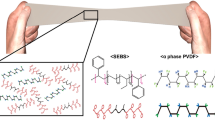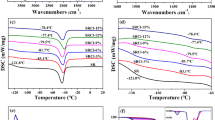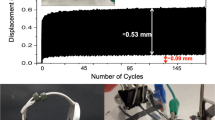Abstract
Slide-ring elastomers have attracted a great deal of interest for their use in dielectric elastomer actuators due to their essential soft character and high elasticity. In general, the slide-ring materials’ usage is limited by their reduced compatibility with usually used elastomer precursors and the specific chemical reactions necessary for their embedding into networks. In this study, we obtained a plasticizing effect on poly(dimethylsiloxane) (PDMS) by using polar fillers based on poly (3,4-ethylenedioxythiophene/permethylated β-cyclodextrin) polypseudorotaxane (PEDOT-PMβCD), its corresponding triphenylmethyl-ended PEDOT∙PMβCD polyrotaxane, as well as the reference, PEDOT. The micrometric agglomerates occurred during the thin film manufacturing have a negligible influence on the thermal behavior of PDMS, taking to a decreased Young's modulus, enhancing the elongation at break and the dielectric permittivity. The results and the figures of merit recommend these materials in electromechanical actuators. The best electromechanical performances were obtained using PEDOT-PMβCD filler, with a low Young’s modulus of 0.17 MPa and a doubling of the electromechanical behavior values, up to 5.6% in comparison with those of PDMS.





Similar content being viewed by others
References
Carpi F, Frediani G, Turco S, De Rossi D (2011) Bioinspired tunable lens with muscle-like electroactive elastomers. Adv Funct Mater 21:4152–4158. https://doi.org/10.1002/adfm.201101253
Tian M, Yao Y, Liu S, Yang D, Zhang L, Nishi T, Ning N (2015) Separated-structured all-organic dielectric elastomer with large actuation strain under ultralow voltage and high mechanical strength. J Mater Chem A 3:1483–1491. https://doi.org/10.1039/C4TA04197F
Skov AL, Yu L (2018) Optimization techniques for improving the performance of silicone-based dielectric elastomers. Adv Eng Mater 20:1700762(21pp). https://doi.org/10.1002/adem.201700762
Brochu P, Pei Q (2010) Advances in dielectric elastomers for actuators and artificial muscles. Macromol Rapid Commun 31:10–36. https://doi.org/10.1002/marc.200900425
Racles C, Ursu C, Dascalu M, Asandulesa M, Tiron V, Bele A, Tugui C, Teodoroff-Onesim S (2020) Multi-stimuli responsive free-standing films of DR1-grafted silicones. Chem Eng J 401:126087(14pp). https://doi.org/10.1016/j.cej.2020.126087
Pelrine R, Kornbluh R, Pei Q, Joseph J (2000) High-speed electrically actuated elastomers with strain greater than 100%. Science 287:836–839. https://doi.org/10.1126/science.287.5454.836
Gallone G, Carpi F, De Rossi D, Levita G, Marchetti A (2007) Dielectric constant enhancement in a silicone elastomer filled with lead magnesium niobate-lead titanate. Mater Sci Eng C 27:110–116. https://doi.org/10.1016/j.msec.2006.03.003
Dang ZM, Xu HP, Wang HY (2007) Significantly enhanced low-frequency dielectric permittivity in the BaTiO3/poly(vinylidene fluoride) nanocomposite. Appl Phys Lett 90:012901(3pp). https://doi.org/10.1063/1.2393150
Dimiev A, Zakhidov D, Genorio B, Oladimeji K, Crowgey B, Kempel L, Rothwell EJ, Tour JM (2013) Permittivity of dielectric composite materials comprising graphene nanoribbons. The effect of nanostructure. ACS Appl Mater Interfaces 5:7567–7573. https://doi.org/10.1021/am401859j
Zhou T, Zha JW, Cui RY, Fan BH, Yuan JK, Dang ZM (2011) Improving dielectric properties of BaTiO3/ferroelectric polymer composites by employing surface hydroxylated BaTiO3 nanoparticles. ACS Appl Mater Interfaces 3:2184–2188. https://doi.org/10.1021/am200492q
Barber P, Pellechia PJ, Ploehn HJ, zur Loye HC, (2010) High-dielectric polymer composite materials from a series of mixed-metal phenylphosphonates, ATi(C6H5PO3)3 for dielectric energy storage. ACS Appl Mater Interfaces 5:2553–2559. https://doi.org/10.1021/am1003987
Molberg M, Crespy D, Rupper P, Nüesch F, Månson JAE, Löwe C, Opris DM (2010) High breakdown field dielectric elastomer actuators using encapsulated polyaniline as high dielectric constant filler. Adv Funct Mater 20:3280–3291. https://doi.org/10.1002/adfm.201000486
Luo S, Yu S, Sun R, Wong CP (2013) Nano Ag-deposited BaTiO3 hybrid particles as fillers for polymeric dielectric composites: toward high dielectric constant and suppressed loss. ACS Appl Mater Interfaces 6:176–182. https://doi.org/10.1021/am404556c
Zhao H, Wang DR, Zha JW, Zhao J, Dang ZM (2013) Increased electroaction through a molecular flexibility tuning process in TiO2–polydimethylsilicone nanocomposites. J Mater Chem A 1:3140–3145. https://doi.org/10.1039/C2TA01026G
Yang D, Tian M, Dong Y, Liu H, Yu Y, Zhang L (2012) Disclosed dielectric and electromechanical properties of hydrogenated nitrile–butadiene dielectric elastomer. Smart Mater Struct 21:035017(6pp). https://doi.org/10.1088/0964-1726/21/3/035017
Racles C, Cozan V, Bele A, Dascalu M (2016) Polar silicones: structure-dielectric properties relationship. Des Monomers Polym 19:496–507. https://doi.org/10.1080/15685551.2016.1169381
Madsen FB, Yu L, Mazurek PS, Skov AL (2016) A simple method for reducing inevitable dielectric loss in high-permittivity dielectric elastomers. Smart Mater Struct 25:075018 (14pp). https://doi.org/10.1088/0964-1726/25/7/075018
Opris DM (2018) Polar elastomers as novel materials for electromechanical actuator applications. Adv Mater 30:1703678(23pp). https://doi.org/10.1002/adma.201703678
Madsen FB, Daugaard AE, Hvilsted S, Skov AL (2016) The current state of silicone-based dielectric elastomer transducers. Macromol Rapid Commun 37(5):378–413. https://doi.org/10.1002/marc.201500576
Yu L, Skov AL (2018) Molecular strategies for improved dielectric elastomer electrical breakdown strengths. Macromol Rapid Commun 39:1800383(6pp). https://doi.org/10.1002/marc.201800383
Racles C, Bele A, Dascalu M, Musteata VE, Varganici CD, Ionita D, Vlad S, Cazacu M, Duenki SJ, Opris DM (2015) Polar-nonpolar interconnected elastic networks with increased permittivity and high breakdown fields for dielectric elastomer transducers. RSC Adv 5(72):58428–58438. https://doi.org/10.1039/C5RA06865G
Skov AL, Yu L (2018) Optimization techniques for improving the performance of silicone-based dielectric elastomers. Adv Eng Mater 20(5):1700762(21pp). https://doi.org/10.1002/adem.201700762
Cazacu M, Racles C, Zaltariov M-F, Dascalu M, Bele A, Tugui C, Bargan A, Stiubianu G (2021) From amorphous silicones to Si-containing highly ordered polymers: Some Romanian contributions in the field. Polymers 13:1605(21pp). https://doi.org/10.3390/polym13101605
Kato K, Inoue K, Kidowaki M, Ito K (2009) Organic-inorganic hybrid slide-ring gels: polyrotaxanes consisting of poly(dimethylsiloxane) and γ-cyclodextrin and subsequent topological cross-linking. Macromolecules 42:7129–7136. https://doi.org/10.1021/ma9011895
Wu J, He H, Chao G (2010) β-Cyclodextrin-capped polyrotaxanes: one-pot facile synthesis via click chemistry and use as templates for platinum nanowires. Macromolecules 43:2252–2260. https://doi.org/10.1021/ma902255v
Harada A, Li J, Kamachi M (1992) The molecular necklace: a rotaxane containing many threaded α-cyclodextrins. Nature 356:325–327. https://doi.org/10.1038/356325a0
Fujita H, Ooya T, Yui N (1999) Thermally induced localization of cyclodextrins in a polyrotaxane consisting of β-Cyclodextrins and poly(ethylene glycol)-poly(propylene glycol) triblock copolymer. Macromolecules 32:2534–2541. https://doi.org/10.1021/ma9814550
Ohmori K, Abu Bin I, Seki T, Liu C, Mayumi K, Ito K, Takeoka Y (2016) Molecular weight dependency of polyrotaxane-cross-linked polymer gel extensibility. Chem Commun (Camb) 52:13757–13759. https://doi.org/10.1039/c6cc07641f
Bin Imran A, Esaki K, Gotoh H, Seki T, Ito K, Sakai Y, Takeoka Y (2014) Extremely stretchable thermosensitive hydrogels by introducing slide-ring polyrotaxane cross-linkers and ionic groups into the polymer network. Nat Commun 5:5124(8pp). https://doi.org/10.1038/ncomms6124
Yang D, Ge F, Tian M, Ning N, Zhang L, Zhao C, Ito K, Nishi T, Wang H, Luan Y (2015) Dielectric elastomer actuator with excellent electromechanical performance using slide-ring materials/barium titanate composites. J Mater Chem A 3:9468–9479.https://doi.org/10.1039/C5TA01182E
Okumura Y, Ito K (2001) The polyrotaxane gel: A topological gel by figure-of-eight cross-links. Adv Mater 13(7):485–487
Zhuo Y, Li T, Wang F, Håkonsen V, Xiao S, He J, Zhang Z (2019) Ultra-durable icephobic coating by molecular pulley. Soft Matter 15:3607–3611. https://doi.org/10.1039/C9SM00162J
Minato K, Mayumi K, Maeda R, Kato K, Yokoyama H, Ito K (2017) Mechanical properties of supramolecular elastomers prepared from polymer-grafted polyrotaxane. Polymer 128:386–391. https://doi.org/10.1016/j.polymer.2017.02.090
Facchetti A (2011) π-Conjugated polymers for organic electronics and photovoltaic cell applications. Chem Mater 23:733–758. https://doi.org/10.1021/cm102419z
Xue J (2010) Perspectives on organic photovoltaics Polym Rev 50:411–419. https://doi.org/10.1080/15583724.2010.515766
Liang Y, Yu L (2010) Development of semiconducting polymers for solar energy harvesting. Polym Rev 50:454–473. https://doi.org/10.1080/15583724.2010.515765
Brovelli S, Cacialli F (2010) Optical and electroluminescent properties of conjugated polyrotaxanes. Small 6:2796–2820. https://doi.org/10.1002/smll.201001881
Frampton MJ, Anderson HL (2007) Insulated molecular wires. Angew Chemie Int Ed 46:1028–1064. https://doi.org/10.1002/anie.200601780
Putnin T, Le H, Bui T-T, Jakmunee J, Ounnunkad K, Péralta S, Aubert P-H, Goubard F, Farcas A (2018) Poly(3,4-ethylenedioxythiophene/permethylated β-cyclodextrin) polypseudorotaxane and polyrotaxane: Synthesis, characterization and application as hole transporting materials in perovskite solar cells. Eur Polym J 105:250–256. https://doi.org/10.1016/j.eurpolymj.2018.06.005
Araki J, Kataoka T, Ito K (2008) Preparation of a “sliding graft copolymer”, an organic solvent-soluble polyrotaxane containing mobile side chains, and its application for a crosslinked elastomeric supramolecular film. Soft Matter 4:245–249. https://doi.org/10.1039/B715231K
Mayumi K, Ito K, Kato K (2016) Polyrotaxane and Slide-Ring Materials. The Royal Society of Chemistry, Cambridge. https://doi.org/10.1039/9781782622284
Noda Y, Hayashi Y, Ito K (2014) From topological gels to slide-ring materials. J Appl Polym Sci 131:40509(9pp). https://doi.org/10.1002/APP.40509
Yang D, Ge F, Tian M, Ning N, Zhang L, Zhao C, Ito K, Nishi T, Wang H, Luane Y (2015) Dielectric elastomer actuator with excellent electromechanical performance using slide-ring materials/barium titanate composites. J Mater Chem A 3:9468–9479. https://doi.org/10.1039/c5ta01182e
Du R, Xu Z, Zhu C, Jiang Y, Yan H, Wu H-C, Vardoulis O, Cai Y, Zhu X, Bao Z, Zhang Q, Jia X (2020) A highly stretchable and self-healing supramolecular elastomer based on sliding crosslinks and hydrogen bonds. Adv Funct Mater 30:1907139(9pp). https://doi.org/10.1002/adfm.201907139
Marciniec B (2009) Functionalisation and cross-linking of organosilicon polymers, Hydrosilylation: A comprehensive review on recent advances, B. Marciniec, Ed., Springer Netherlands, Dordrecht 159–189
Tran J-A, Madsen J, Skov AL (2020) Utilizing slide-ring cross-linkers in polysiloxane networks for softer dielectric elastomer actuators. Proc. SPIE 11375, Electroactive Polymer Actuators and Devices (EAPAD) XXII, 1137518. https://doi.org/10.1117/12.2557355
Tran J-A, Madsen J, Skov AL (2021) Novel polyrotaxane cross-linkers as a versatile platform for slide-ring silicone. Bioinspir Biomim 16:025002(10pp). https://doi.org/10.1088/1748-3190/abdd9f
Cazacu M, Racles C, Vlad A, Antohe M, Forna N (2009) Silicone-based Composite for Relining of Removable Dental Prosthesis. J Compos Mater 43:2045–2055. https://doi.org/10.1177/0021998309340447
Carpi F, Anderson I, Bauer S, Frediani G, Gallone G, Gei M, Graaf C, Jean-Mistral C, Kaal W, Kofod G, Kollosche M, Kornbluh RD, Lassen B, Matysek M, Michel S, Nowak S, O’Brien B, Pei Q, Pelrine R, Rechenbach B, Rosset S, Shea HR (2015) Standards for dielectric elastomer transducers. Smart Mater Struct 24:105025. https://doi.org/10.1088/0964-1726/24/10/105025
Xie Y, Zhang S-H, Jiang H-Y, Zeng H, Wu R-M, Chen H, Gao Y-F, Huang Y-Y, Bai H-L (2019) Properties of carbon black-PEDOT composite prepared via in-situ chemical oxidative polymerization. e-Polymers 19:61–69. https://doi.org/10.1515/epoly-2019-0008
Voronkov MG, Mileshkevich VP, Yuzhelevskii YuA (1978) The siloxane bond, Physical properties and chemical transformations, Consultants Bureau, New York and London
Hyeok Choi U, Liang S, Chen Q, Runt J, Colby RH (2016) Segmental dynamics and dielectric constant of polysiloxane polar copolymers as plasticizers for polymer electrolytes. ACS Appl Mater Interfaces 8:3215–3225. https://doi.org/10.1021/acsami.5b10797
Cadogan DF, Howick CJ (1996) Plasticizers. John Wiley & Sons
Bele A, Cazacu M, Stiubianu G, Vlad S (2014) Silicone-barium titanate composites with increased electromechanical sensitivity. The effects of the filler morphology. RSC Adv 4:58522–58529. https://doi.org/10.1039/c4ra09903f
Racles C, Musteata VE, Bele A, Dascalu M, Tugui C, Matricala AL (2015) Highly stretchable composites from PDMS and polyazomethine fine particles. RSC Adv 5:102599–102609. https://doi.org/10.1039/c5ra12297j
Kremer F, Schonhals A, Luck W (2002) Broadband dielectric spectroscopy. Springer-Verlag, Berlin
Racles C, Alexandru M, Musteata V, Bele A, Cazacu M, Opris DM (2014) Tailoring the dielectric properties of silicones by chemical modification, in: Recent Res. Dev. Polym. Sci., Transworld Research Network, Kerala, India pp 17–36
Dascalu M, Iacob M, Tugui C, Bele A, Stiubianu G-T, Racles C, Cazacu M (2021) Octakis(phenyl)-T8-silsesquioxane-filled silicone elastomers with enhanced electromechanical capability. J Appl Polym Sci 138:e50161 (10pp). https://doi.org/10.1002/app.50161
Razak AHA, Szabo P, Skov AL (2015) Enhancement of dielectric permittivity by incorporating PDMS-PEG multiblock copolymers in silicone elastomers. RSC Adv 5:53054–53062. https://doi.org/10.1039/c5ra09708h
Acknowledgements
This work was supported by a grant of the Ministry of Research, Innovation and Digitization, CNCS/CCCDI–UEFISCDI, project number PN-III-P1-1.1-PD-2019-0148 (SilWebWEH), within PNCDI III.
Author information
Authors and Affiliations
Corresponding author
Ethics declarations
Conflicts of interest
The authors declare no conflict of interest.
Additional information
Publisher's Note
Springer Nature remains neutral with regard to jurisdictional claims in published maps and institutional affiliations.
Supplementary information
Below is the link to the electronic supplementary material.
Rights and permissions
About this article
Cite this article
Bele, A., Dascalu, M., Tugui, C. et al. Silicone elastomers with improved electro-mechanical performance using slide-ring polymers. J Polym Res 29, 202 (2022). https://doi.org/10.1007/s10965-022-03051-0
Received:
Accepted:
Published:
DOI: https://doi.org/10.1007/s10965-022-03051-0




